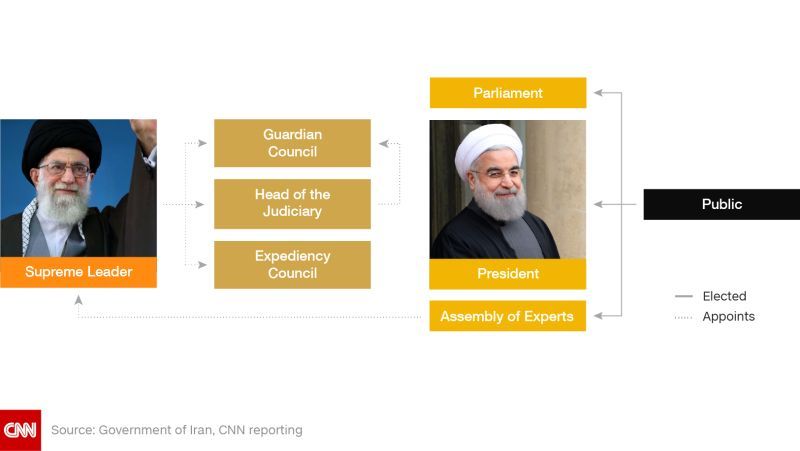For the first time ever, Iranians on Friday voted to elect two key government bodies at the same time: lawmakers to the 290-seat Parliament and 88 members for the Assembly of Experts.
As the final results are being announced, here are four key things to know about the election:
1. Congratulations to Rouhani, but changes will come slowly.
The elections boosted the moderates, but it does not give them a free hand.
Unexpectedly, tens of millions of eligible Iranian voters thronged polling stations hoping to influence the fate of their nation regarding engagement with the world, and their social, political, economic landscapes.
Out of 290 seats, the reformist and their moderate allies won 83 of the parliamentary seats, conservatives 78, independents 60, and five minority representatives. Reformists also won 15 of Tehran's 16 seats for the Assembly of Experts, a crucial body that would determine the country's next supreme leader.
This shows that the reformists outnumbered the conservatives. The combined list of moderates and their reformist allies won a majority in the next parliament. Meanwhile, the number of hardliners has considerably decreased, with a loss of 44 seats.
How Iran's government works.

The independents are more likely to ally with the reformists and moderates rather than the hardliners. Out of the 290 seats in parliament, 226 have been filled.
No conservative was elected in the capital as the reformists won all 30 seats in Tehran.
In April, 128 candidates will run for the second round of elections for the remaining 64 seats.
The elections propelled moderates and reformists to their best electoral finish since 2004. This will definitely deliver a boost to President Hassan Rouhani's government since these elections were also viewed as a referendum on Rouhani's policies.
The outcome demonstrated that the majority of Iranians are either confident in the political direction that Rouhani's moderate, educated and technocrat team is taking, or they voted to prevent the conservative hardliners, who oppose engagements with the West, from winning the elections.
2. Turnout, Turnout, Turnout: Iranians spoke out against the hardliners
The elections had a surprisingly high turnout. Nearly 55 million of Iran's 80 million people were eligible to vote. Of that number, around 60 percent -- which is about 33 million -- turned up at the polls to decide their country's future.
Although the elections were largely restricted, with the candidates pre-selected by the Guardian Council, the stakes were still high. The huge turnout meant that Iranians felt their vote ultimately made a difference.
3. Iranian youth and social media matter more than ever
The elections showed a new reality: the youth and social media rule. Polls were filled with young Iranians attempting to capitalize on the limited socio-political space granted to them.
Around 60 percent of the population are under 30, born after the Islamic Revolution.
Although the conservative Guardian Council disqualified many reformist candidates, the youth did not get discouraged. They went to the polls mainly to prevent the radical right from getting into the government.
Nastaran, a 32-year-old teacher from Shiraz, told me: "I am voting not because any of the candidates is what I desire, my candidate was disqualified. I am voting because I do not want the hardliner to win. It is a choice between worse and the worst".
Through social media campaigns and groups chats via apps such as Telegram, young people organized to oust hardliners. Disillusioned with the Islamic Revolution's principles, the majority of Iranian youth sent a robust signal that they prefer more engagement with the world, more freedoms, and an improved economy.
4. Diplomacy and more business: Expect further opening up to the world
By having additional support from the parliament, Rouhani's government will be in a stronger position to continue its current diplomatic rapprochement with Europe and the United States, as well as opening up Iran's market to western businesses.
However, Iran-U.S. rapprochement will occur at a much slower pace due to the hardline stance of the current Supreme Leader, Ayatollah Ali Khamenei, towards Washington. The victory of moderates and their reformist allies does not mean there is going to be swift, fundamental changes in Iran's foreign and domestic policy.
Hardliners still have a firm hold, having won several seats in parliament. Supreme Leader Khamenei, the Judiciary, the Intelligence Ministry (Etela'at), and the Islamic Revolutionary Guards still enjoy a considerable amount of political and economic power. Undoubtedly, they will use this leverage to prevent moderates and reformists from making significant change.
Nevertheless, with the high election turnout, the defeat of two influential conservative clerics Ayatollah Mohammad Yazdi (the incumbent head of the assembly) and Ayatollah Mohammad-Taghi Mesbah Yazdi, as well as the victory of the moderates, former President Ali Akbar Hashemi Rafsanjani and Hassan Rouhani, it is obvious that most Iranians are not wanting a conservative Supreme Leader to succeed Khamenei.
Moderate President Rouhani and his allies won 15 out of Tehran's 16 seats in the election for the Assembly. This points to the strong possibility that a moderate Supreme Leader could succeed Khamenei.
If this happens, it could have a significant impact on Iran's domestic and foreign policies, and could well improve Iran's ties with the West, particularly the U.S.
As the Persian saying goes: "Drop by drop gathers to become an ocean."
Majid Rafizadeh is an author, political scientist, human rights activist, public speaker and TV commentator on U.S. foreign policy and the Middle East. The opinions expressed in this commentary are his.
